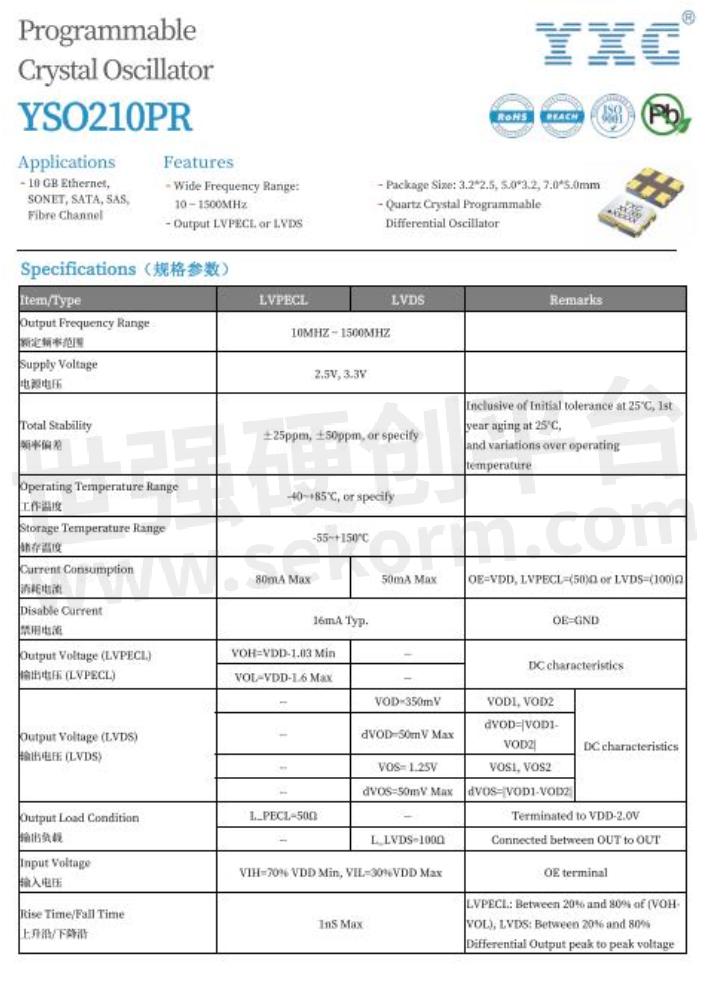YXC Programmable Differential Crystal Oscillator YSO210PR Series, Frequency 155.52MHz, LVPECL Output, Used in Switches

A switch is a network device that is mainly used for forwarding electrical (optical) signals, allowing independent communication between any two network nodes connected to the switch.
Switches are not limited to Ethernet applications, but also come in many forms such as telephone voice switches and fiber optic switches to meet different network needs.

Fig.1
Switches require a stable clock signal to synchronize the transmission and processing of network data. Crystal oscillators provide such clock signals to ensure that switches can accurately control the forwarding, reception and processing of data packets, thereby ensuring the stability and reliability of the network.
At the same time, switches are connected to other devices in the network through various network interfaces (such as Ethernet ports, fiber optic ports, etc.). The clock signal of the crystal oscillator is used to control the operation of the network interface to ensure accurate transmission and reception of data.
In addition, switches usually need to send management information or perform performance monitoring regularly to ensure the normal operation of the network. The clock signal provided by the crystal oscillator is used to synchronize the operation of the management and monitoring modules to ensure that the switch can perform management and monitoring tasks in a timely and accurate manner.
The following are the typical parameters of OA2EIC112-155.52M in the active crystal oscillator YSO210PR series launched by YXC and its application characteristics in switches:
1. 155.52MHz differential programmable oscillator provides accurate clock signals for the system. This series supports customization of any frequency point in the frequency range of 10-1500MHz, which can be accurate to six decimal places, with fast delivery, and batch delivery within one week at the fastest.
2. In the range of -40~+85℃, the frequency stability is ±50PPM, with high precision and low jitter, ensuring the stability of high-speed data transmission and no packet loss;
3. The differential input subtracts the complementary signal from the real signal to generate a single-ended signal with twice the amplitude relative to the input
YXC crystal oscillator YSO210PR series, the frequency is 155.52MHz, the total frequency difference is ±50PPM, and the following is the YSO210PR series specification.

Fig.1
- +1 Like
- Add to Favorites
Recommend
- YXC Programmable Differential Oscillator, Frequency 50MHz, 7050 package, LVDS output, applied to SVG
- YXC Quartz Active Differential Programmable Crystal Oscillator YSO210PR, Frequency 200MHZ, Decimal Point Can be Accurate to The Last 6 Digits, Applied to 5g Base Station
- YXC Programmable Crystal Oscillator, Frequency 27MHz, Package 2016, Frequency Difference ±50ppm, Used in Mobile Phone Screen
- YXC High-frequency Differential Crystal Oscillator, Frequency 312.5MHz, High Precision and High Stability, Applied to Ai Acceleration Card
- YXC Programmable Differential Oscillator, Featuring a Frequency of 125MHz and LVDS Output, is Designed for Use in Urine Analyzers
- YXC Crystal Oscillator Solutions Help Industrial Camera Applications
- Optical Modules Remain Popular, with The Best Time-Frequency Cp-Differential Crystal Oscillator
- YXC Programmable Differential Crystal Oscillator, Frequency 148.5MHz, LVDS Output, 5032 Package, Used in High-end Cameras
This document is provided by Sekorm Platform for VIP exclusive service. The copyright is owned by Sekorm. Without authorization, any medias, websites or individual are not allowed to reprint. When authorizing the reprint, the link of www.sekorm.com must be indicated.





























































































































































































































































































































































































































































































































































































































































































































































































































































































